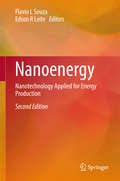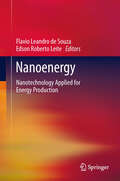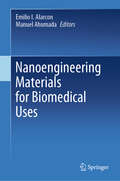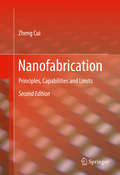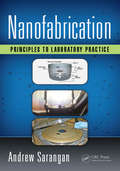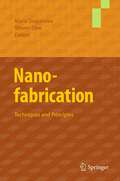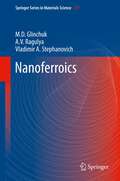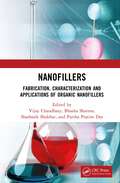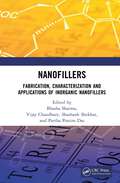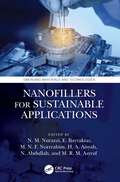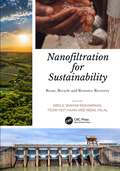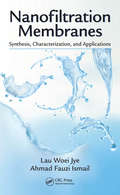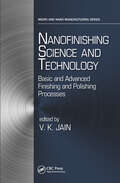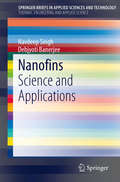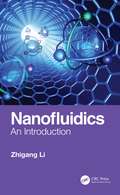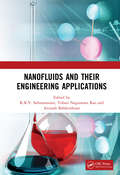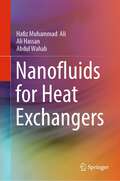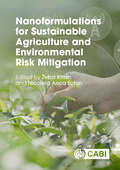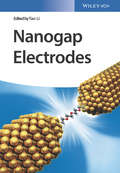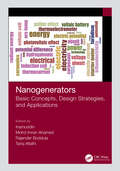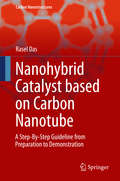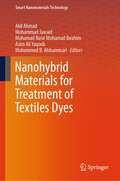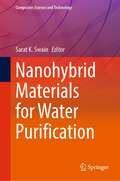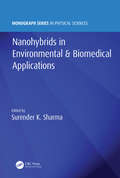- Table View
- List View
Nanoenergy
by Edson Leite Flavio Leandro de SouzaLow dimensional systems have revolutionized the science and technology in several areas. However, their understanding is still a great challenge for the scientific community. Solar energy conversion devices based on nanostructured materials have shown exceptional gains in efficiency and stability. In this context, nanostructures allow an improvement of surface properties, transport and charge transfer, as well as direct application as sensors and storage devices and energy conversion. This book discuss the recent advances and future trends of the nanoscience in solar energy conversion and storage. It explores and discusses recent developments both in theory as well as in experimental studies and is of interest to materials scientists, chemists, physicists and engineers.
Nanoenergy
by Edson Roberto Leite Flavio Leandro de SouzaLow dimensional systems have revolutionized the science and technology in several areas. However, their understanding is still a great challenge for the scientific community. Solar energy conversion devices based on nanostructured materials have shown exceptional gains in efficiency and stability. In this context, nanostructures allow an improvement of surface properties, transport and charge transfer, as well as direct application as sensors and storage devices and energy conversion. This book discuss the recent advances and future trends of the nanoscience in solar energy conversion and storage. It explores and discusses recent developments both in theory as well as in experimental studies and is of interest to materials scientists, chemists, physicists and engineers.
Nanoengineering Materials for Biomedical Uses
by Emilio I. Alarcon Manuel AhumadaThis book fills the gap between fundamental and applied research in the use of nanomaterials in biomedical applications, covering the most relevant areas, such as the fundamental concepts of the preparation of nanostructures and regulatory requirements for their safe use in biomedical devices. It also critically discusses what has been achieved in the field, and what needs to be urgently addressed and reviews the state-of-the-art medical uses of nanomaterials for treating damaged organs and tissues.Combining the expertise of clinical researchers working in the field of tissue engineering and novel materials, the book explores the main topics regarding the characterization of materials, specific organ-oriented biomaterials and their applications, as well as regulations and safety. Further, it also examines recent advances, difficulties, and clinical requirements in terms of human bone, cornea, heart, skin and the nervous system, allowing readers to gain a clear and comprehensive understanding of current nanomaterial use in biomedical applications and devices, together with the challenges and future trends.This book is a valuable tool for multidisciplinary scientists and experts interested in fundamental concepts and synthetic routes for preparing nanomaterials. It is also of interest to students and researchers involved in cross-disciplinary research in nanomaterials for clinical applications and offers practical insights for clinicians as well as engineers and materials scientists working in nanoengineering.
Nanofabrication
by Zheng CuiThis book provides the reader with the most up-to-date information and development in the Nanofabrication area. It presents a one-stop description at the introduction level on most of the technologies that have been developed which are capable of making structures below 100nm. Principles of each technology are introduced and illustrated with minimum mathematics involved. The book serves as a practical guide and first hand reference for those working in nanostructure fabrication.
Nanofabrication: Principles to Laboratory Practice (Optical Sciences and Applications of Light)
by Andrew SaranganThis book is designed to introduce typical cleanroom processes, techniques, and their fundamental principles. It is written for the practicing scientist or engineer, with a focus on being able to transition the information from the book to the laboratory. Basic theory such as electromagnetics and electrochemistry is described in as much depth as necessary to understand and explain the current practice and their limitations. Examples from various areas of interest will be covered, such as the fabrication of photonic devices including photo detectors, waveguides, and optical coatings, which are not commonly found in other fabrication texts.
Nanofabrication
by Maria Stepanova Steven DewIntended to update scientists and engineers on the current state of the art in a variety of key techniques used extensively in the fabrication of structures at the nanoscale. The present work covers the essential technologies for creating sub 25 nm features lithographically, depositing layers with nanometer control, and etching patterns and structures at the nanoscale. A distinguishing feature of this book is a focus not on extension of microelectronics fabrication, but rather on techniques applicable for building NEMS, biosensors, nanomaterials, photonic crystals, and other novel devices and structures that will revolutionize society in the coming years.
Nanoferroics
by A. V. Ragulya M. D. Glinchuk Vladimir A. StephanovichThis book covers the physical properties of nanosized ferroics, also called nanoferroics. Nanoferroics are an important class of ceramic materials that substitute conventional ceramic ferroics in modern electronic devices. They include ferroelectric, ferroelastic, magnetic and multiferroic nanostructured materials. The phase transitions and properties of these nanostructured ferroics are strongly affected by the geometric confinement originating from surfaces and interfaces. As a consequence, these materials exhibit a behavior different from the corresponding bulk crystalline, ceramic and powder ferroics. This monograph offers comprehensive coverage of size- and shape-dependent effects at the nanoscale; the specific properties that these materials have been shown to exhibit; the theoretical approaches that have been successful in describing the size-dependent effects observed experimentally; and the technological aspects of many chemical and physico-chemical nanofabrication methods relevant to making nanoferroic materials and composites. The book will be of interest to an audience of condensed matter physicists, material scientists and engineers, working on ferroic nanostructured materials, their fundamentals, fabrication and device applications.
Nanofertilizers for Sustainable Agroecosystems: Recent Advances and Future Trends (Nanotechnology in the Life Sciences)
by Kamel A. Abd-Elsalam Mousa A. AlghuthaymiLarge-scale chemical fertilizer application causes irreparable damage to soil structure, mineral cycles, soil microbial flora, plants, and other food chains across ecosystems, culminating in heritable mutations in future generations of consumers. A better way forward is the use of nanofertilizers to focus on macro elements (N, P, K), as switching to nanofertilizers may result in large environmental benefits by replacing the majority of these nutrients. Furthermore, the biosynthesis of nanomaterials using bacteria, algae, yeast, fungus, actinomycetes, and plants has opened up a new avenue of research in the production of inorganic nanoparticles as ecologically friendly fertilizers. Nanofertilizers should also attain increased efficiency because of a several-fold increase in the surface-to-volume ratio of nano-forms of nutrients and their suitability for foliar application, where environmental losses are further reduced. Nanostructured fertilizers can also improve nutrient use efficiency through strategies such as targeted distribution and progressive or controlled-release as they can precisely release their active molecules in response to environmental cues and biological demands. Recent research shows nanofertilizers can increase agricultural productivity by speeding up seed germination, seedling growth, photosynthetic activity, nitrogen metabolism, and carbohydrate and protein synthesis. The potential agricultural benefits of nanofertilizers, their modes of action, and the fate of nanomaterials in soil are all discussed in this book. It also covers nanofertilizer formulation and delivery, applications, uptake, translocation, and their fate in plants, as well as their impact on plant physiology and metabolism. Nutrient nanoformulation is a valuable method that has the potential to alter the agricultural sector and provide solutions to current and future concerns for sustainable and climate-sensitive crops
Nanofillers: Fabrication, Characterization and Applications of Organic Nanofillers
by Vijay Chaudhary Bhasha Sharma Shashank Shekhar Partha Pratim DasThis book explores the modifying effects of various nanofillers on mechanical and physical properties of polymer nanocomposites. Looking at the four basic aspects of processing, characterization, properties, and applications, it analyzes how their features can allow for innovative multifunction within industry. Covering design, production, and manufacture, this book focuses on meeting end-use requirements and the fabrication of materials. The importance of mindful design and the use of an appropriate synthesis method is the primary lens through which theory and practice are discussed. This volume looks at the various synthesis methods available for organic nanofillers and what characterizes them. Properties including mechanical, thermal, electrical, and tribological are thoroughly examined, along with the various computational techniques used to determine them. With important sustainable properties, nanofillers are essential to meeting the increasing demand for biodegradable and environmentally friendly materials. This book details the role nanofillers have to play in sustainability, alongside economic factors such as efficient manufacturing processes. This book will appeal to both academic and industrial engineers involved with nanofillers in a variety of industries, including automotive, aerospace, and biomedical engineering.
Nanofillers: Fabrication, Characterization and Applications of Inorganic Nanofillers
by Bhasha Sharma Vijay Chaudhary Shashank Shekhar Partha Pratim DasAnalyzing the modifying effects of various inorganic nanofillers on the mechanical properties of polymer nanocomposites, this book covers processing, characterization, properties, and applications to analyze how these materials allow for innovative multifunction. This volume looks at various synthesis methods available within inorganic nanofillers and what characterizes them, covering design, manufacturing processes, and end-user results. The chapters focus on metal oxides, energy storage, and devices, alongside polymers used for packaging. This book details the role inorganic nanofillers have to play in cost-effective manufacturing processes due to their strength and efficiency, and their subsequent relevance to low-cost yet high-performance materials. Covering topics such as corrosion resistance, wear resistance, strength, and characterization, this book is an essential companion for any engineer working with inorganic nanofillers. This book will be of interest to engineers involved with inorganic nanofillers in a variety of industries, including automotive, aerospace, and biomedical engineering.
Nanofillers for Sustainable Applications (Emerging Materials and Technologies)
by N. M. NurazziNanofillers for Sustainable Applications provides an in-depth review of the wide-ranging applications of nanofillers. It explores both synthetic and natural nanofillers and focuses on their use as reinforcement and active fillers in composite structures. Covering various aspects of nanofillers, including synthesis methods, characteristics, properties, and compatibility, this book highlights the potential of nanofillers as functional materials for different applications and offers a collection of comparative studies to showcase their efficacy. It emphasizes sustainability, intelligent design, and high-end applications in fields such as packaging, pulp and paper, aerospace, automotive, medicine, chemical industry, biodiesel, and chemical sensors. This book is organized into several sections, covering topics such as synthetic nanomaterials, nanosafety, natural nanofillers, polymer composites, metal nanofillers, nanofillers in various industries, nanofillers in renewable energy, nanofillers in biomedical sectors, and nanofillers in automotive and aerospace industries. This book will be a useful reference for undergraduate and graduate students and academic researchers in the fields of materials science, nanomaterials, and polymer composites. Key features: • Focuses on the fabrication approaches used for nanofillers in nanocomposites. • Covers materials selection, design solutions, manufacturing techniques, and structural analysis, highlighting their potential as functional materials in different applications. • Explores the positive environmental impact and material property improvements resulting from increased composite utilization across diverse industries. • Discusses other types of nanofillers like nanocellulose, metal-based, graphene, and wood-based materials. • Includes case studies from leading industrial and academic experts.
Nanofiltration for Sustainability: Reuse, Recycle and Resource Recovery
by Abdul Wahab MohammadThis book provides a novel exploration of the application of nanofiltration membrane technology for sustainability in various industries, situated in view of recent breakthroughs and the use of reuse, recycle and resource recovery approaches. Moving from a comprehensive discussion of nanofiltration membrane processes to case studies and real-world applications of nanofiltration technology across society, both successes and potential limitations are considered. Features: Detailed discussion of the fundamentals of nanofiltration technology The concepts of reuse, recycle and resource recovery using nanofiltration technology are explored in combination with other technologies to advance circular economy Considered across a range of industries, such as textiles, oil, gas, agriculture and pharmaceutics Written in a thoroughly detailed manner, this book is an essential guide for industry professionals interested in sustainability and working toward a circular economy. Comprehensive discussions of the fundamental processes underpinning nanofiltration technology also make this book particularly appealing to students of industrial chemistry.
Nanofiltration Membranes: Synthesis, Characterization, and Applications
by Lau Woei Jye Ahmad Fauzi IsmailCovering fabrication, characterization, and applications nanofiltration (NF) membranes, this book provides a comprehensive overview of the development of NF membrane technology over the past decade. It uniquely covers a variety of fabrication techniques, comparing the procedures of each technique to produce polymeric membranes of different morphologies. The book also discusses advances in the materials used in thin film composite (TFC) polyamide membrane fabrication and their influences on properties with respect to structural and separation characteristics. A comprehensive review on NF characterization methods and techniques is provided, assessing physical and chemical properties and separation characteristics and stability. Technical challenges in fabricating a new generation of NF membranes are also reviewed and the possible approaches to overcome the challenges are provided. The book concludes with relevant case studies on the use of NF membranes in industrial implementation of both aqueous and nonaqueous media. Details the latest progress on the fabrication techniques of asymmetric and composite NF membranes. Discusses characterization methods used in assessing membrane physical/chemical properties, separation characteristics, and performance stability. Describes the potential of advanced materials in improving properties of polyamide selective layer as well as microporous substrate. Reviews the technical challenges in fabricating a new generation of composite membrane—thin film nanocomposite (TFN) membrane—possible approaches to overcome challenges. Offers case studies on the applications of NF membranes for both aqueous and nonaqueous media.
Nanofinishing Science and Technology: Basic and Advanced Finishing and Polishing Processes (Micro and Nanomanufacturing Series)
by V. K. JainFinishing is the final operation after a part is sized and shaped. Currently in high tech industries, there is a demand for nano level surface finishing of components. This process is done to improve the surface finish, to remove the recast layer, or to remove surface and sub-surface defects. The result is low friction, longer product life, and low power requirements. Equally important is the aesthetic aspect of the product. This subject is growing very fast from the technology as well as a science point of view. Books on this subject are very limited, particularly those ones that deal with both the science as well as the technology aspects.
Nanofins
by Navdeep Singh Debjyoti BanerjeeNanofins Science and Technology describes the heat transfer effectiveness of polymer coolants and their fundamental interactions with carbon nanotube coatings that act as nanofins. Heat transfer at micro/nano-scales has attracted significant attention in contemporary literature. This has been primarily driven by industrial requirements where significant decrease in the size of electronic devices/chips with concomitant enhancement in the heat flux have caused challenging needs for cooling of these platforms. With quantum effects kicking in, traditional cooling techniques need to be replaced with more effective technologies. A promising technique is to enhance heat transfer by surface texturing using nanoparticle coatings or engineered nanostructures. These nanostructures are termed as nanofins because they augment heat transfer by a combination of surface area enhancement as well as liquid-solid interactions at the molecular scale.
Nanofluidics: An Introduction
by Zhigang LiThis book provides an introduction to nanofluidics in a simple manner and can be easily followed by senior undergraduate students, graduate students, and other researchers who have some background in fluid mechanics. The book covers the main topics about the fundamentals of nanofluidics and how it differs from classic fluid mechanics. It also describes the methodologies of nanofluidics, including numerical approaches, e.g., molecular dynamics simulation and experimental techniques. Fundamental physics and new phenomena in nanofluidics are the major concerns of this book. The author goes on to discuss nanocofinements and the parameters that affect the fluid dynamics at the nanoscale and make flow analysis complex. These parameters accommodate rich, new flow phenomena that may not be observed at the macro- and microscale. Although not all of the new phenomena will find widespread applications, the physics underlying these new phenomena may offer insights for other fields. This is one of the reasons why this book emphasizes the mechanisms of various flow fashions. Explores the unique characteristics of nanoscale flows and related properties Reviews the latest research of nanoscale ion transport and its applications Discusses the fluid flows in nanoconfinements in a unique manner based on the author's original research Incorporates important applications of nanofluidics throughout.
Nanofluids and Their Engineering Applications
by Avinash Balakrishnan Tubati Nageswara Rao K.R.V. SubramanianNanofluids are solid-liquid composite material consisting of solid nanoparticles suspended in liquid with enhanced thermal properties. This book introduces basic fluid mechanics, conduction and convection in fluids, along with nanomaterials for nanofluids, property characterization, and outline applications of nanofluids in solar technology, machining and other special applications. Recent experiments on nanofluids have indicated significant increase in thermal conductivity compared with liquids without nanoparticles or larger particles, strong temperature dependence of thermal conductivity, and significant increase in critical heat flux in boiling heat transfer, all of which are covered in the book. <P><P>Key Features Exclusive title focusing on niche engineering applications of nanofluids Contains high technical content especially in the areas of magnetic nanofluids and dilute oxide based nanofluids Feature examples from research applications such as solar technology and heat pipes Addresses heat transfer and thermodynamic features such as efficiency and work with mathematical rigor Focused in content with precise technical definitions and treatment
Nanofluids for Heat Exchangers
by Hafiz Muhammad Ali Ali Hassan Abdul WahabThis book describes the importance of heat transfer in heat exchangers, and fluids properties play a vital role to increase heat transfer rate translating the size of the equipment and cuts in the capital and running cost in the long term. Nanofluids applications in heat exchangers will help to improve the thermophysical properties of the fluid and therefore heat transfer. And, this book explains the enhancing mechanisms of heat transfer by employing nanofluids in heat exchangers. A critical discussion will enable to estimate the pros and cons of such fluids in different types of heat exchangers. Prevailing working conditions for short- and long-term implementation of various types of nanofluids will be discussed and introduced to the readers. This book helps the researchers, scientist and academicians working in the domain to be able to get a comprehensive knowledge at one place regarding the preparation, properties, measurements, data reduction, characteristics and applications of nanofluids in heat exchangers.
Nanoformulations for Sustainable Agriculture and Environmental Risk Mitigation
by Anda Maria Baroi Mirela Florina Calinescu Georgiana Cîrstea Dobrescu Codruta Mihaela Dorobat Leonard Magdalin Oana Alexandra Draghiceanu Eladl Eltanahy Irina Fierascu Radu Claudiu Fierascu Rauzah Hashim Amany Saad Hegazy Khairul Anwar Ishak Dilki Jayathilaka K. G. Kaushani Nilwala Kottegoda Neblea Monica Angela Daniela Nicuta Alina Ortan Yehia A Osman Gheorghe Cristian Popescu Monica Popescu Gayan Priyadarshana Ahmed A Razak Ana-Maria Rosu Chanaka Sandaruwan Ionela Daniela Khaled Sayed-Ahmed Yasser M Shabana Liliana Cristina Soare Gayanath Thiranagama Camelia Ungureanu Denisa Stefania Vîlcoci Diana Vizitiu Roxana-Elena VoicuNanotechnology research and its application in agriculture has become a major focus in recent years. Nanoformulations offer the possibility to develop more efficient and less damaging agrochemicals in the environment. Smart delivery systems for nanosensors, molecules that can help to detect biotic or abiotic stresses before they can affect production, are being developed and applied. Nanotechnology also provides new techniques for genetic manipulation and plant breeding. The use of nanoformulations in agriculture is increasingly being used to enhance food values, reduce agricultural inputs, improve nutrient contents and create a longer shelf life for many products. Nanotechnology is also being applied to many aspects of food security, disease treatment, new tools for pathogen detection, effective delivery systems and packaging materials. All of these applications are supposed to assist in addressing the needs of a growing population, and help in mitigating the effects of climate change and other ecological disturbances. This book highlights new applications of these nanoforms in the field of agricultural science, written by an international team of experts from across this broad discipline. It is essential reading for graduate students, researchers and practitioners involved in the application of nanotechnology in agriculture. The book: · examines the role of nano-formulations in crop yield improvement whilst reducing reliance on chemical fertilizers and pesticides; · covers specially enabled delivery systems for the release of nanoformulations, field-sensing systems to monitor environmental stresses, and improvement of plant traits against environmental stress and diseases; · is unambiguous, lucid, scientific and precise, with chapters supplemented by ample illustration and case studies to help clarify and summarize key points throughout.
Nanogap Electrodes
by Tao LiUnique in its scope, this book comprehensively combines various synthesis strategies with applications for nanogap electrodes. Clearly divided into four parts, the monograph begins with an introduction to molecular electronics and electron transport in molecular junctions, before moving on to a whole section devoted to synthesis and characterization. The third part looks at applications with single molecules or self-assembled monolayers, and the whole is rounded off with a section on interesting phenomena observed using molecular-based devices.
Nanogenerators: Basic Concepts, Design Strategies, and Applications
by InamuddinThis book provides an in-depth review of the history, fundamental theory, design strategies, and applications of nanogenerators. Working principles, device mechanisms, material characteristics, types of nanogenerators, and their different uses are fully explored.Top researchers in the field of sustainable technology from different backgrounds and fields contribute their expertise to deliver a must-have practical resource for students, academic researchers, and industry professionals.FEATURES Describes the fundamental aspects and theory of nanogenerators Explores design strategies including material assessment based upon planned application Tailors the introduction and essential concept discussion for the industrial and research community Explores current applications, existing challenges, and the future outlook for the field
Nanohybrid Catalyst based on Carbon Nanotube: A Step-By-Step Guideline from Preparation to Demonstration (Carbon Nanostructures)
by Rasel DasThis book introduces carbon nanotubes as a matrix for efficient nanohybrid catalysis. The preparation and use of such materials in ultra-grade water purification is described. Simple chemical methods for purification and functionalization of carbon nanotubes prior to their use is also detailed. The author also discusses the potential use of nanotube-based nanobiohybrid catalysts in the removal of organic pollutants.
Nanohybrid Materials for Treatment of Textiles Dyes (Smart Nanomaterials Technology)
by Akil Ahmad Mohammad Jawaid Mohamad Nasir Mohamad Ibrahim Asim Ali Yaqoob Mohammed B. AlshammariThis book covers the various aspects of nanohybrid materials and its composites for their application in treatment of toxic textiles dyes for cleaning the environment especially water and wastewater. The book first looks into the various preparation and characterization techniques for nanohybrid materials. The replacement of other conventional materials with highly efficient (high surface area, pore size, and chemical and mechanical strength) nanohybrid materials and their application in the field of environmental purification through treatment of textile dyes is highlighted in the later part of the book. The book caters to students, researchers, and scientists who are working in the field of wastewater treatment for incorporating novel materials to remove toxic textile dyes from contaminated wastewater.
Nanohybrid Materials for Water Purification (Composites Science and Technology)
by Sarat K. SwainThis book comprehensively reviews the key topics in the area of nanocomposites and hybrid materials used for waste water treatment and purification. It covers materials chemistry, various synthesis approaches and properties of these nanomaterials for the different water purification techniques. It provides new direction to the readers to better understand the chemistry behind these materials and the methods to improve their properties. This book will be a very valuable reference source for graduates and postgraduates, engineers, research scholars (primarily in the field of material science, water, nanoscience and nanotechnology), material scientists, researchers in the water-related area, scientists working in water treatment plans and pollution mitigation industries.
Nanohybrids in Environmental & Biomedical Applications (Monograph Series in Physical Sciences)
by Surender Kumar SharmaHeterostructured nanoparticles have the capability for a broad range of novel and enhanced properties, which leads to appealing biomedical and environmental applications. This timely new book addresses the design and preparation of multiphase nanomaterials with desired size, shape, phase composition, and crystallinity, as well as their current applications. It emphasizes key examples to motivate deeper studies, including nanomaterial-based hyperthermia treatment of cancer, nanohybrids for water purification, nanostructures used in the removal or detection of bioagents from waste water, and so on. Features Presents state of the art research on heterostructured nanomaterials, from their synthesis and physiochemical properties to current environmental and biological applications. Includes details on toxicity and risk assessment of multifunctional nanomaterials. Discusses recent developments and utilization in healthcare by leading experts. Introduces the main features of functionalization of nanomaterials in terms of desired size, shape, phase composition, surface functionalization/coating, toxicity, and geometry. Emphasizes practical applications in the environmental and biomedical sectors.
